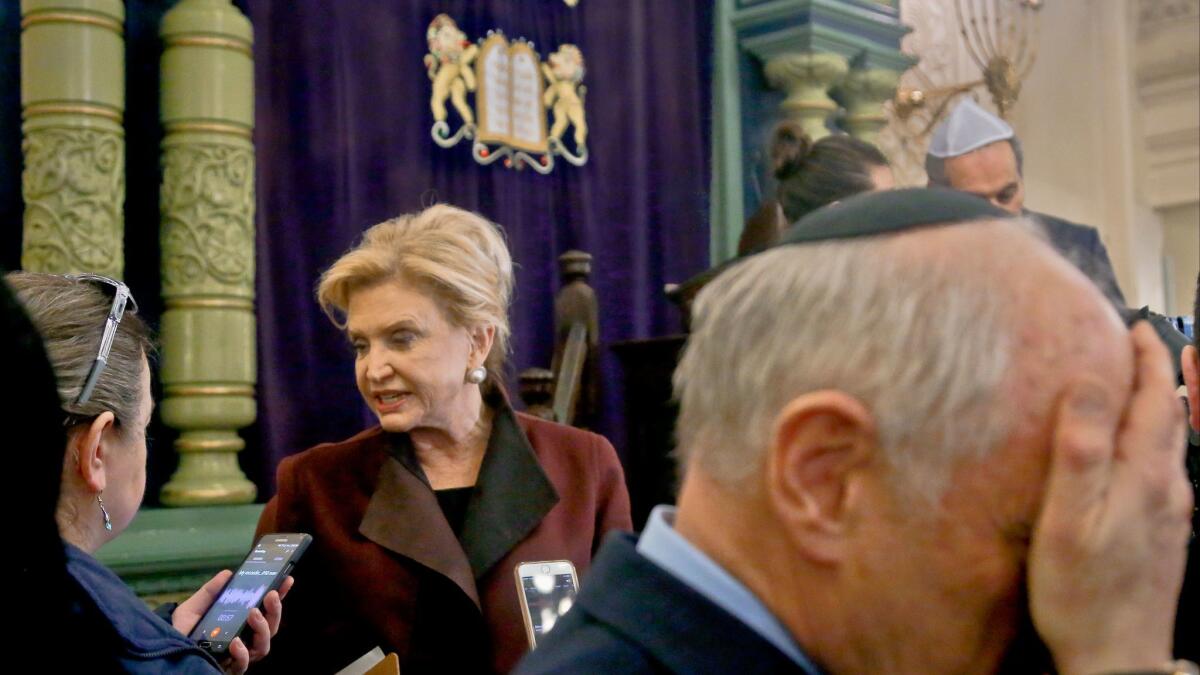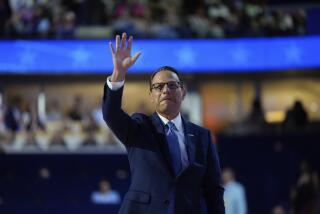Anti-Semitic incidents have reached levels unseen in recent years, Anti-Defamation League report says

A regional director for the civil rights group said politicians were partly responsible for the uptick. (Sign up for our free video newsletter here http://bit.ly/2n6VKPR)
- Share via
The number of anti-Semitic incidents in the U.S. skyrocketed by 86% in the first three months of the year, according to a new report released Monday by a prominent Jewish civil rights organization.
The Anti-Defamation League’s audit of anti-Semitic events counted 541 anti-Semitic attacks and threats against Americans in the first quarter of the year, a dramatic increase over the same period last year.
The incidents followed an overall 34% increase in anti-Semitic assaults, vandalism and harassment last year when compared with 2015, according to the report.
The surge in anti-Semitic incidents in the United States came against an overall drop in such incidents worldwide, according to a report issued Sunday by the Kantor Center for the Study of Contemporary European Jewry at Tel Aviv University.
The Kantor report, which surveyed approximately 40 countries, said incidents of anti-Semitism dropped 12% globally. In France, home to Europe’s largest Jewish community, reports of anti-Semitic acts dropped 61%. However, the English-speaking world in general bucked the trend, with increases in Britain, Australia and, especially, the United States. The report noted that anti-Semitic incidents on U.S. college campuses rose by 45%.
While the trend line was down overall worldwide, the report pointed with alarm to a “continuation of the widespread increase, sometimes dramatic, in verbal and visual anti-Semitism on social media and during demonstrations … that cannot be quantified.”
According to the ADL report, this year’s numbers in the U.S. were part of an uptick that began before the new year. Close to one-third of the 1,266 incidents logged last year happened in November and December.
“It’s really incredibly alarming,” said Jonathan Greenblatt, chief executive of the New York-based civil rights group, which pulls data from law enforcement, victims and local Jewish organizations to compile its annual audit. “What’s most concerning is the fact that the numbers have accelerated over the past five months.”

Greenblatt attributed the increases to several factors.
Part of this year’s growth, he said, was the 161 hoax bomb threats against Jewish community centers and other Jewish institutions, including the ADL itself. Two men — an American in St. Louis and a dual citizen Israeli American teen in Israel — have been arrested and charged separately with committing the crimes. But those threats, which began in January, count for less than a third of the incidents this year.
Greenblatt also said the increases were due to the presidential election and a rise in activity among white supremacists.
His group found 34 instances last year that were related to the election. Among them: graffiti discovered in Denver in May that said, “Kill the Jews, Vote Trump,” and an incident in November in which a St. Petersburg, Fla., man was accosted by someone who told him, “Trump is going to finish what Hitler started.”
Civil rights groups, including the ADL, had criticized President Trump during his campaign for retweeting white supremacists and using anti-Semitic imagery, which they said emboldened anti-Semites.
Jewish organizations also called out the Trump administration after his inauguration for a series of stumbles and missed opportunities when it came to the Jewish community. These included the White House intentionally leaving out the mention of Jews in a statement on Holocaust Remembrance Day, Trump waiting six weeks before denouncing dozens of hoax bomb threats that had put U.S. Jewish institutions on edge, and the president berating an Orthodox Jewish reporter who asked him about anti-Semitism during a February news conference.
In another instance this month, White House Press Secretary Sean Spicer apologized after he was criticized for saying Hitler did not use chemical weapons on his own people — a statement that ignored the use of gas chambers to kill millions of Jews and other people deemed undesirable, many of them Germans. Spicer also incorrectly referred to concentration camps as “Holocaust centers.”
Trump is scheduled to speak Tuesday at the U.S. Holocaust Memorial Museum for the museum’s annual Days of Remembrance ceremony.
Amanda Susskind, a Los Angeles-based regional director for the civil rights group, said she thought politicians were partly responsible for the uptick. She included Trump among them for his initial hesitancy to denounce anti-Semitism.
“When leadership doesn’t speak out against it, that creates a petri dish of an environment where there is no sense that there is anything wrong” with anti-Semitism, Susskind said. Yet, she saw “a general normalization of hate, whether in social media or online or through incidents that are reported,” she said.
California, which has a significant Jewish population, had 211 anti-Semitic incidents last year, the highest number for a U.S. state and a year-to-year increase of 21%. There were 87 anti-Semitic incidents in the state in the first three months of this year.
Jews were also frequently targeted in other states with large Jewish populations, including New York and Florida.
Although ADL leaders said they were worried about an increase in violence and threats against Jews, they noted that anti-Semitic acts have been decreasing overall since the group began tracking incidents in 1979.
Its count reached an all-time high in 1994. That year, the ADL found 2,066 incidents.
“We see anti-Semitism typically increase in times when there is political uncertainty or economic downturn or when Israel makes headlines,” Greenblatt said. In 1994, several deadly clashes between Israelis and Palestinians made international news, and the Israel-Jordan peace treaty was signed.
Since that year, the audit has found little variation in the number of anti-Semitic events. A more recent peak was in 2005, when the group found 1,757 incidents.
In addition to the recent growth in anti-Semitic threats, attacks and vandalism, the civil rights group found in survey results released this month that there has also been a slight rise in anti-Semitic attitudes. The survey found that 14% of Americans hold anti-Semitic views, compared with 12% in a similar poll in 2013. But this year’s poll also found that a majority of Americans say they were worried about violence against Jews in the U.S.
“Clearly, we have work to do and need to bring more urgency to the fight,” Greenblatt said. “But we also need more leaders to speak out against this cancer of hate and more action at all levels to counter anti-Semitism.”
Jaweed Kaleem is The Times’ national race and justice correspondent. Follow him on Twitter, Facebook and Instagram.
ALSO
Neo-Nazi website unleashed Internet trolls against a Jewish woman, lawsuit says
On fourth anniversary of Boston Marathon bombings, a day of public service, resiliency and strength
Can a judge be impartial and an activist? Arkansas jurist who halted executions pushes boundaries
More to Read
Sign up for Essential California
The most important California stories and recommendations in your inbox every morning.
You may occasionally receive promotional content from the Los Angeles Times.











